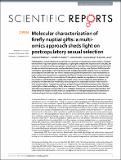| dc.contributor.author | Al-Wathiqui, Nooria | en_US |
| dc.contributor.author | Fallon, Timothy R. | en_US |
| dc.contributor.author | South, Adam | en_US |
| dc.contributor.author | Weng, Jing-Ke | en_US |
| dc.contributor.author | Lewis, Sara M. | en_US |
| dc.date.accessioned | 2017-01-03T23:50:08Z | |
| dc.date.issued | 2016 | en_US |
| dc.identifier.citation | Al-Wathiqui, Nooria, Timothy R. Fallon, Adam South, Jing-Ke Weng, and Sara M. Lewis. 2016. “Molecular characterization of firefly nuptial gifts: a multi-omics approach sheds light on postcopulatory sexual selection.” Scientific Reports 6 (1): 38556. doi:10.1038/srep38556. http://dx.doi.org/10.1038/srep38556. | en |
| dc.identifier.issn | 2045-2322 | en |
| dc.identifier.uri | http://nrs.harvard.edu/urn-3:HUL.InstRepos:29739144 | |
| dc.description.abstract | Postcopulatory sexual selection is recognized as a key driver of reproductive trait evolution, including the machinery required to produce endogenous nuptial gifts. Despite the importance of such gifts, the molecular composition of the non-gametic components of male ejaculates and their interactions with female reproductive tracts remain poorly understood. During mating, male Photinus fireflies transfer to females a spermatophore gift manufactured by multiple reproductive glands. Here we combined transcriptomics of both male and female reproductive glands with proteomics and metabolomics to better understand the synthesis, composition and fate of the spermatophore in the common Eastern firefly, Photinus pyralis. Our transcriptome of male glands revealed up-regulation of proteases that may enhance male fertilization success and activate female immune response. Using bottom-up proteomics we identified 208 functionally annotated proteins that males transfer to the female in their spermatophore. Targeted metabolomic analysis also provided the first evidence that Photinus nuptial gifts contain lucibufagin, a firefly defensive toxin. The reproductive tracts of female fireflies showed increased gene expression for several proteases that may be involved in egg production. This study offers new insights into the molecular composition of male spermatophores, and extends our understanding of how nuptial gifts may mediate postcopulatory interactions between the sexes. | en |
| dc.language.iso | en_US | en |
| dc.publisher | Nature Publishing Group | en |
| dc.relation.isversionof | doi:10.1038/srep38556 | en |
| dc.relation.hasversion | http://www.ncbi.nlm.nih.gov/pmc/articles/PMC5177949/pdf/ | en |
| dash.license | LAA | en_US |
| dc.title | Molecular characterization of firefly nuptial gifts: a multi-omics approach sheds light on postcopulatory sexual selection | en |
| dc.type | Journal Article | en_US |
| dc.description.version | Version of Record | en |
| dc.relation.journal | Scientific Reports | en |
| dash.depositing.author | South, Adam | en_US |
| dc.date.available | 2017-01-03T23:50:08Z | |
| dc.identifier.doi | 10.1038/srep38556 | * |
| dash.contributor.affiliated | South, Adam | |


